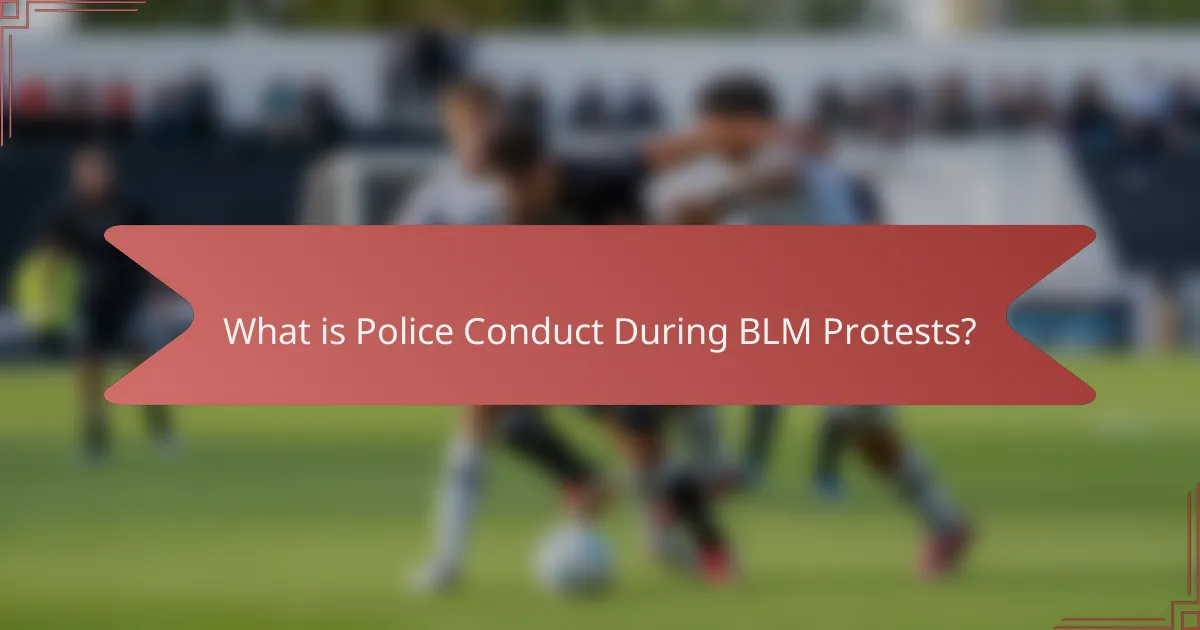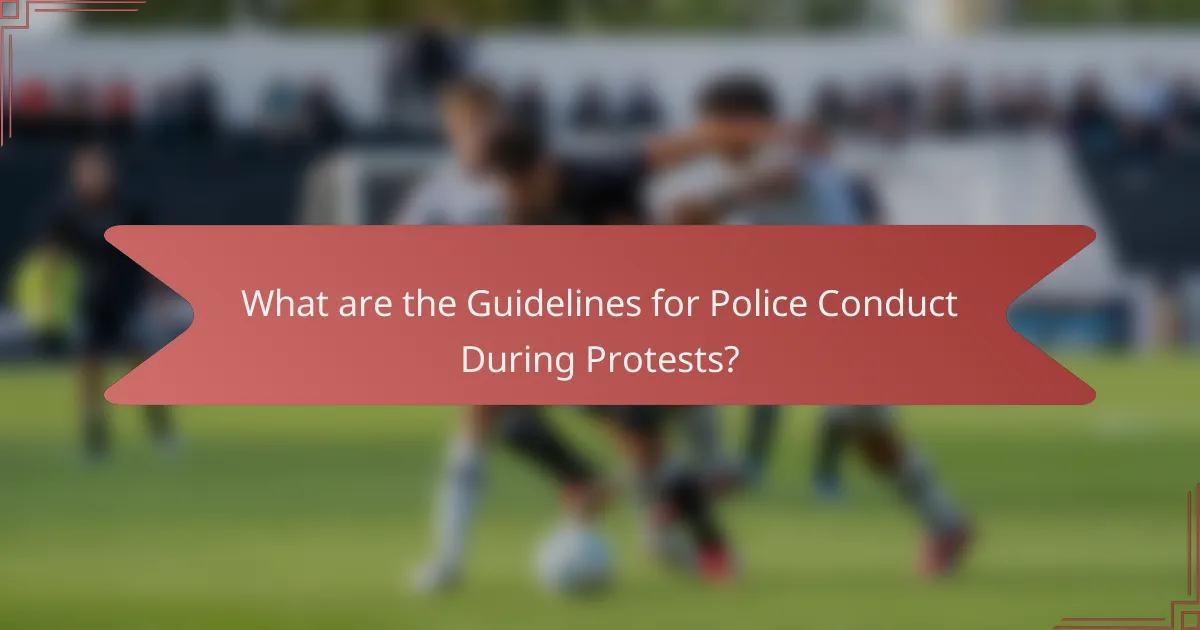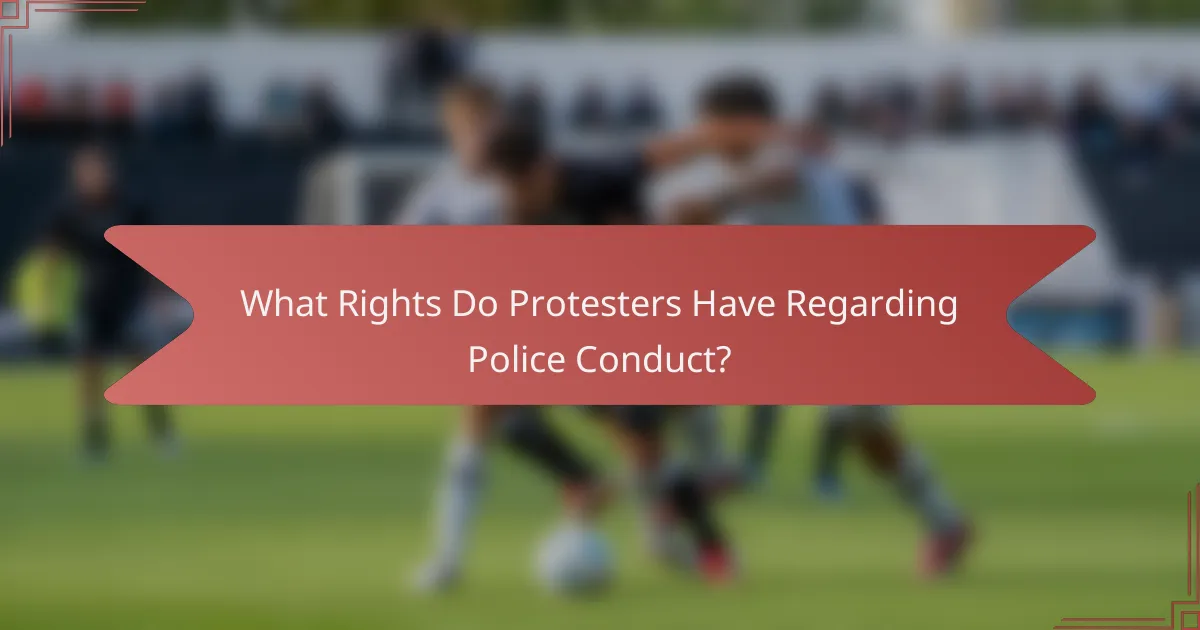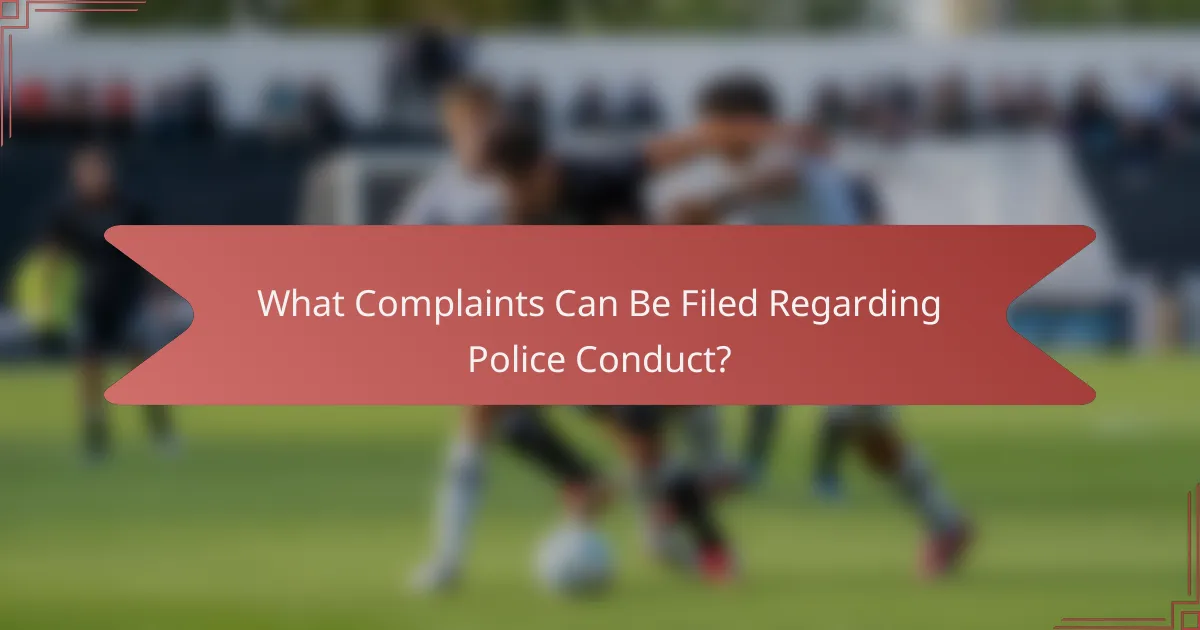
What is Police Conduct During BLM Protests?
Police conduct during BLM protests typically involves maintaining public order while respecting citizens’ rights. Law enforcement agencies are often tasked with ensuring safety for both protesters and bystanders. Guidelines generally emphasize de-escalation techniques, communication with protest organizers, and minimizing the use of force. During protests, police may establish designated areas for demonstrations and monitor crowd behavior.
Reports indicate that aggressive tactics, such as tear gas and rubber bullets, have been criticized in many instances. The use of such measures can escalate tensions and lead to public outcry. In some cases, police departments have implemented reforms in response to community feedback. For example, the Seattle Police Department adopted a new crowd management policy after protests in 2020.
Overall, police conduct during BLM protests is a complex interplay of maintaining order and upholding civil liberties.
How is police conduct defined in the context of protests?
Police conduct in the context of protests refers to the behavior and actions of law enforcement during public demonstrations. This conduct is often defined by the principles of maintaining public order while respecting citizens’ rights to free speech and assembly. Guidelines typically emphasize de-escalation, respect for demonstrators, and proportional use of force. For instance, the International Association of Chiefs of Police advocates for a community policing approach during protests. This approach promotes communication between officers and protesters. Additionally, police conduct is scrutinized based on accountability measures and oversight mechanisms. Historical data shows that improper conduct can lead to public outcry and legal consequences.
What are the legal frameworks governing police conduct?
Legal frameworks governing police conduct include constitutional laws, statutory regulations, and case law. The U.S. Constitution, particularly the Fourth Amendment, protects against unreasonable searches and seizures. This amendment shapes police procedures by requiring probable cause for arrests. Additionally, the Fourteenth Amendment mandates due process, impacting how police conduct investigations and interactions.
Statutory laws, such as the Violent Crime Control and Law Enforcement Act, establish standards for police conduct. These laws often dictate the use of force, accountability measures, and community relations. Case law further defines police conduct through judicial rulings. Landmark cases like Tennessee v. Garner set precedents on the use of deadly force.
State laws also contribute to the legal framework. Each state has its own statutes governing police practices, which can vary significantly. Collectively, these legal frameworks aim to balance law enforcement duties with citizens’ rights.
How do policies vary between different jurisdictions?
Policies vary significantly between different jurisdictions regarding police conduct during protests. Each jurisdiction establishes its own rules and regulations based on local laws and community standards. For example, some cities may mandate de-escalation techniques, while others do not. Additionally, the level of accountability and oversight can differ widely. In some areas, independent review boards oversee police actions, whereas in others, internal reviews are the norm. Jurisdictions may also have varying policies on the use of force, crowd control tactics, and the presence of officers in riot gear. These differences can impact how protests are managed and the rights of individuals involved. Overall, the variation in policies reflects local governance and community values.
Why is understanding police conduct important during BLM protests?
Understanding police conduct during BLM protests is crucial for ensuring accountability and protecting civil rights. Police actions can significantly impact the safety and effectiveness of protests. Historical instances show that improper police conduct can lead to violence and escalation. For example, during the 2020 protests, reports indicated excessive use of force by law enforcement. Understanding these actions helps individuals recognize their rights and navigate interactions with police. It also informs advocacy for policy changes and reforms. Knowledge of police conduct aids in documenting incidents for potential legal action. Overall, awareness promotes a safer environment for protestors and fosters constructive dialogue about systemic issues.
What impact does police conduct have on public perception?
Police conduct significantly influences public perception. Positive interactions can foster trust and community support. Conversely, negative encounters can lead to distrust and fear. Studies show that high-profile incidents of police misconduct can result in widespread protests. For instance, the killing of George Floyd in 2020 sparked global demonstrations and calls for reform. Research indicates that communities perceive police as more legitimate when they engage respectfully. Transparency and accountability in police actions also enhance public confidence. Ultimately, police conduct shapes the narrative around law enforcement in society.
How can police conduct influence protest outcomes?
Police conduct can significantly influence protest outcomes by shaping the environment and participants’ reactions. Peaceful engagement by police can lead to less tension and more constructive dialogue. Conversely, aggressive tactics can escalate conflicts and provoke violence. Research shows that police presence and behavior directly affect public sentiment and protest dynamics. For instance, studies indicate that de-escalation strategies reduce arrests and injuries, promoting a more peaceful protest atmosphere. Historical examples, such as the response during the BLM protests, demonstrate that community relations are crucial for effective policing. Positive interactions can foster trust, while negative encounters can lead to unrest and further protests.

What are the Guidelines for Police Conduct During Protests?
Police conduct during protests should prioritize the protection of public safety and the constitutional rights of individuals. Guidelines include maintaining a neutral stance and facilitating peaceful assembly. Officers must avoid excessive force and use de-escalation techniques. Communication with protest organizers is essential to ensure safety and order. Police should identify themselves and their roles clearly. They must respect individuals’ rights to free speech and assembly. Documentation of incidents is necessary for accountability. Training on cultural sensitivity and community engagement is vital for effective policing during protests. These guidelines are reinforced by various law enforcement standards and policies across the United States.
What are the key principles of police conduct during protests?
Key principles of police conduct during protests include de-escalation, respect for rights, and accountability. De-escalation aims to minimize tensions and prevent violence. Police should engage with protestors peacefully and avoid aggressive tactics. Respect for rights involves upholding the constitutional rights of individuals, including freedom of speech and assembly. Officers must recognize and protect these rights during protests. Accountability requires police to act transparently and be held responsible for their actions. This principle ensures public trust and oversight. These principles are vital for maintaining order while respecting civil liberties during protests.
How do these principles promote public safety?
These principles promote public safety by ensuring transparency and accountability in police conduct. They establish clear guidelines that officers must follow during protests. This clarity helps prevent excessive force and abuse of power. When police actions are regulated, community trust increases. Trust leads to better cooperation between law enforcement and the public. Improved communication reduces the likelihood of conflict during protests. Studies show that communities with transparent policing have lower crime rates. Overall, these principles create a safer environment for both protesters and the general public.
What role does de-escalation play in these guidelines?
De-escalation plays a critical role in these guidelines by promoting peaceful interactions. It aims to reduce tensions during confrontations. Effective de-escalation techniques can prevent the escalation of conflicts. This approach helps maintain public safety and trust. Guidelines emphasize training officers in de-escalation methods. Research shows that de-escalation techniques can lower the likelihood of violence. The National Institute of Justice supports this by highlighting successful outcomes in various scenarios. Overall, de-escalation is essential for ensuring respectful and constructive police-community relations during protests.
How should police engage with protesters according to guidelines?
Police should engage with protesters in a manner that is respectful and communicative. Guidelines emphasize de-escalation techniques to minimize tensions. Officers should provide clear instructions and information about legal rights. They must avoid using excessive force unless absolutely necessary. Establishing a dialogue with protest leaders can foster cooperation. Transparency about police actions helps build trust within the community. Historical data shows that positive engagement reduces the likelihood of violence. Studies indicate that respectful interactions lead to more peaceful outcomes during protests.
What are the recommended communication strategies?
Recommended communication strategies include active listening, clear messaging, and empathy. Active listening ensures that all parties feel heard and understood. Clear messaging helps to convey information effectively without ambiguity. Empathy fosters trust and rapport between law enforcement and the community. These strategies are essential during interactions to minimize misunderstandings. Research by the National Institute of Justice highlights that effective communication reduces conflict in high-tension situations. Implementing these strategies can lead to more constructive dialogues during protests.
How can police ensure the right to peaceful assembly is respected?
Police can ensure the right to peaceful assembly is respected by facilitating communication with organizers. Clear dialogue helps establish parameters for the assembly. Police should provide guidance on legal requirements for permits. They must also ensure that officers are trained on the rights of individuals. Respecting the assembly’s purpose is crucial. Officers should avoid unnecessary force and engage with demonstrators peacefully. Monitoring the event without interference can help maintain order. Historical context shows that proactive measures reduce tensions during protests.

What Rights Do Protesters Have Regarding Police Conduct?
Protesters have the right to peacefully assemble and express their views without interference from law enforcement. This right is protected under the First Amendment of the U.S. Constitution. Additionally, protesters are entitled to protection from excessive force or unlawful arrests by police. Courts have ruled that police must respect the rights of individuals to express dissent. The Department of Justice has guidelines stating that police should facilitate peaceful protests. Violations of these rights can lead to legal consequences for law enforcement. In cases of misconduct, protesters can file complaints with oversight bodies. Historical cases, such as the 1965 Selma protests, highlight the importance of protecting these rights.
What are the fundamental rights of protesters during BLM events?
Protesters during BLM events have fundamental rights that include the right to free speech, assembly, and petition. These rights are protected under the First Amendment of the United States Constitution. The right to free speech allows individuals to express their opinions and advocate for change. The right to assembly permits groups to gather peacefully for demonstrations. The right to petition enables citizens to make their grievances known to the government. These rights are essential for a functioning democracy. Legal precedents, such as Tinker v. Des Moines Independent Community School District, affirm these rights in public spaces. Additionally, protesters are protected from unreasonable searches and seizures under the Fourth Amendment. These legal protections ensure that individuals can voice their concerns without fear of retaliation.
How do constitutional rights apply to protest situations?
Constitutional rights apply to protest situations primarily through the First Amendment. The First Amendment guarantees freedoms concerning speech, assembly, and petition. It protects individuals’ rights to express their views through peaceful protests. This includes the right to gather in public spaces and voice dissent. Courts have upheld these rights in numerous cases, emphasizing their importance in a democratic society. For example, the landmark case Tinker v. Des Moines Independent Community School District affirmed students’ rights to protest. Additionally, the right to free speech includes symbolic speech, such as wearing armbands or holding signs. However, these rights are subject to reasonable time, place, and manner restrictions. Law enforcement must balance public safety with the protection of constitutional rights during protests.
What protections exist against unlawful police actions?
Protections against unlawful police actions include constitutional rights and legal remedies. The Fourth Amendment protects individuals from unreasonable searches and seizures. The First Amendment safeguards the right to free speech and assembly. Citizens can file complaints with internal affairs or civilian review boards. Legal actions can be taken under Section 1983 of the Civil Rights Act. This allows individuals to sue for violations of constitutional rights. Additionally, various state laws provide protections against police misconduct. Courts may grant injunctions to prevent unlawful actions. These protections are essential in maintaining accountability and safeguarding civil liberties.
How can protesters assert their rights during interactions with police?
Protesters can assert their rights during interactions with police by knowing their legal rights and calmly communicating them. Familiarity with the First Amendment, which protects the right to free speech and assembly, is essential. Protesters should remain respectful and avoid confrontational behavior. Document any interactions by recording video or taking notes. If detained, protesters should clearly state that they do not consent to searches. They can also request legal representation if questioned. Understanding local laws regarding protests can provide additional protection. These actions help ensure that rights are upheld during police interactions.
What should protesters know about their legal rights?
Protesters should know that they have the right to assemble peacefully. This right is protected under the First Amendment of the U.S. Constitution. Protesters can express their views without fear of retaliation. However, they must comply with local laws regarding permits and designated areas. Law enforcement cannot disperse peaceful protesters without a valid reason. Protesters have the right to record police activities. This right is supported by court rulings affirming the right to document public officials. If arrested, protesters should remain silent and request legal counsel. This is a critical step to protect their rights. Understanding these rights helps protesters navigate interactions with law enforcement effectively.
How can documentation of interactions aid in asserting rights?
Documentation of interactions can significantly aid in asserting rights. It provides a clear record of events and communications. This record can include details such as time, date, location, and the individuals involved. Such documentation serves as evidence in legal contexts. It can support claims of misconduct or rights violations. For instance, video recordings or written accounts can substantiate allegations against law enforcement. Accurate documentation can also help in filing complaints with oversight bodies. Additionally, it fosters accountability among police officers. Evidence from documented interactions can influence investigations and outcomes. Overall, thorough documentation empowers individuals to assert their rights effectively.

What Complaints Can Be Filed Regarding Police Conduct?
Complaints regarding police conduct can include excessive force, racial profiling, and unlawful detention. Individuals may file complaints about police misconduct during protests, including failure to uphold constitutional rights. Complaints can also address inappropriate use of crowd control measures. Additionally, citizens may report instances of harassment or intimidation by officers. Each complaint can be submitted to internal police departments or civilian oversight boards. Documentation of incidents, including videos or witness statements, strengthens these complaints. Various jurisdictions have established procedures for filing complaints, ensuring accountability and transparency in police actions.
What types of complaints can individuals file against police conduct?
Individuals can file complaints against police conduct for various reasons. Common types of complaints include excessive force, racial profiling, unlawful arrest, and harassment. Complaints can also address issues like failure to provide medical assistance and misconduct during protests. Each complaint type reflects specific behaviors or actions by police officers. For example, excessive force refers to situations where officers use more physical power than necessary. Racial profiling involves targeting individuals based on race rather than behavior. These complaints can be submitted to internal affairs divisions or civilian review boards. Many jurisdictions have established procedures for filing these complaints to ensure accountability.
What are the procedures for filing a complaint?
To file a complaint, first identify the appropriate police department or agency. Gather all relevant details about the incident, including date, time, and location. Write a detailed account of the complaint, including specific actions taken by officers. Submit the complaint in writing, either online, by mail, or in person at the police station. Some departments may require a specific form for complaints. Keep a copy of the complaint for your records. Follow up with the department to ensure the complaint is being processed. Many agencies have a designated officer to handle complaints, which can facilitate communication.
How can individuals gather evidence for their complaints?
Individuals can gather evidence for their complaints by documenting incidents thoroughly. They should take detailed notes of the event, including dates, times, and locations. Photographs and videos can serve as strong visual evidence. Witness statements can also provide corroborating accounts of the incident. Collecting any relevant documents, such as police reports or medical records, is essential. Using social media posts or news articles can help establish context. Keeping a record of all communications regarding the complaint is also beneficial. These steps create a comprehensive body of evidence to support the complaint effectively.
How can the outcomes of complaints influence police conduct?
Outcomes of complaints can significantly influence police conduct by prompting policy changes and accountability measures. When complaints are substantiated, they can lead to disciplinary actions against officers. This creates a deterrent effect, encouraging officers to adhere to proper conduct. Additionally, patterns identified in complaints can inform training programs and departmental policies. For instance, a high volume of complaints regarding excessive force may lead to revised use-of-force policies. Research indicates that transparent handling of complaints fosters community trust in law enforcement. This trust can enhance cooperation between police and the communities they serve. Overall, the management of complaints plays a critical role in shaping police practices and promoting ethical conduct.
What role do oversight bodies play in addressing complaints?
Oversight bodies play a crucial role in addressing complaints against police conduct. They serve as independent entities that investigate allegations of misconduct. These bodies ensure accountability within law enforcement agencies. They provide a platform for individuals to voice their concerns. Oversight bodies often review evidence and gather testimonies related to complaints. Their findings can lead to disciplinary actions or policy changes. This process helps restore public trust in policing. Research indicates that effective oversight can reduce instances of police misconduct.
How can community feedback lead to policy changes?
Community feedback can lead to policy changes by providing direct insights into public concerns. It allows policymakers to understand the needs and experiences of the community. Engaging with community members can highlight specific issues related to police conduct. For instance, feedback during BLM protests has shown a demand for accountability and transparency. This information can influence legislative discussions and reform initiatives. Studies indicate that communities with active feedback mechanisms see more responsive governance. Research from the Stanford Social Innovation Review emphasizes the importance of community input in shaping effective policies. By integrating feedback, policymakers can create more equitable and just systems.
What are the best practices for addressing police conduct during protests?
Best practices for addressing police conduct during protests include establishing clear communication channels between law enforcement and protest organizers. This helps to set expectations and reduce misunderstandings. Training police officers on de-escalation techniques is essential to minimize confrontations. Implementing body-worn cameras can enhance accountability and transparency during protests.
Engaging community leaders in discussions about police conduct fosters trust and collaboration. Providing legal observers during protests can document interactions and ensure rights are protected. Creating a process for filing complaints against police misconduct offers a formal avenue for accountability. Lastly, regular reviews of police policies and practices can ensure they align with community standards and expectations.
The main entity of this article is police conduct during Black Lives Matter (BLM) protests. The article provides a comprehensive overview of the guidelines governing police behavior, emphasizing the importance of maintaining public order while respecting citizens’ rights to free speech and assembly. It discusses legal frameworks, variations in policies across jurisdictions, and the significance of understanding police conduct for accountability and civil rights protection. Additionally, the article outlines the rights of protesters, procedures for filing complaints against police misconduct, and the role of community feedback in shaping police policies. Key principles such as de-escalation, communication strategies, and the impact of police conduct on public perception and protest outcomes are also explored.